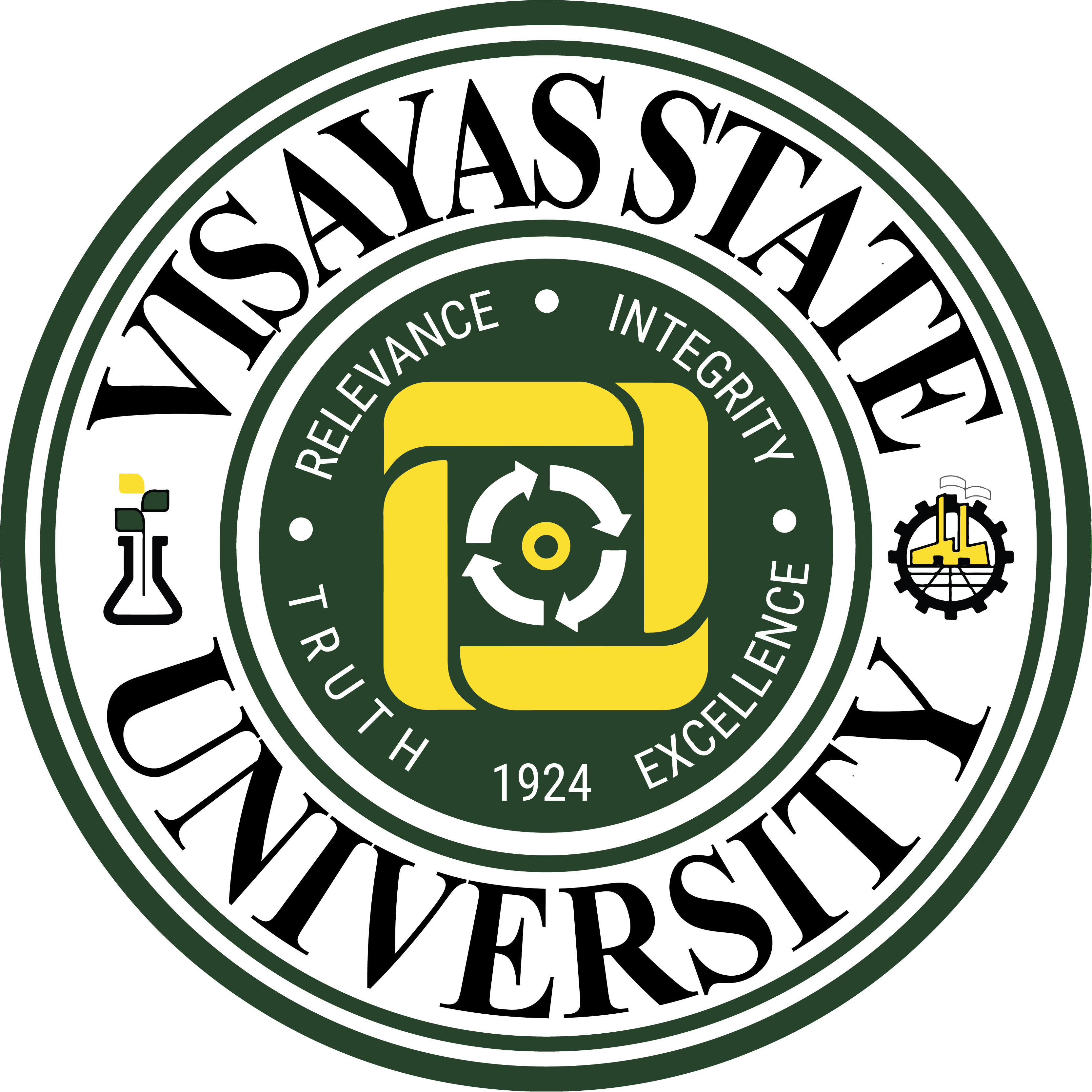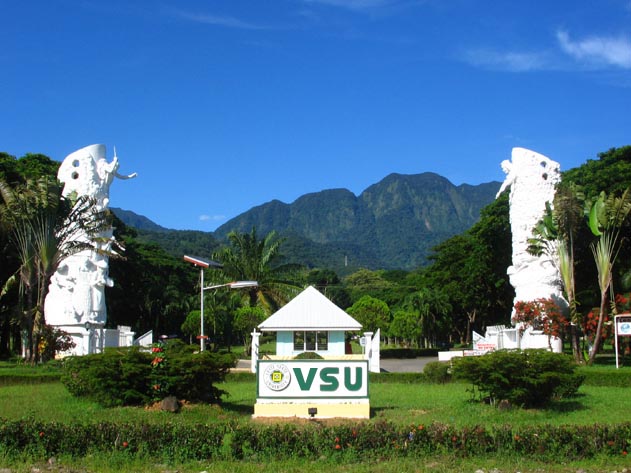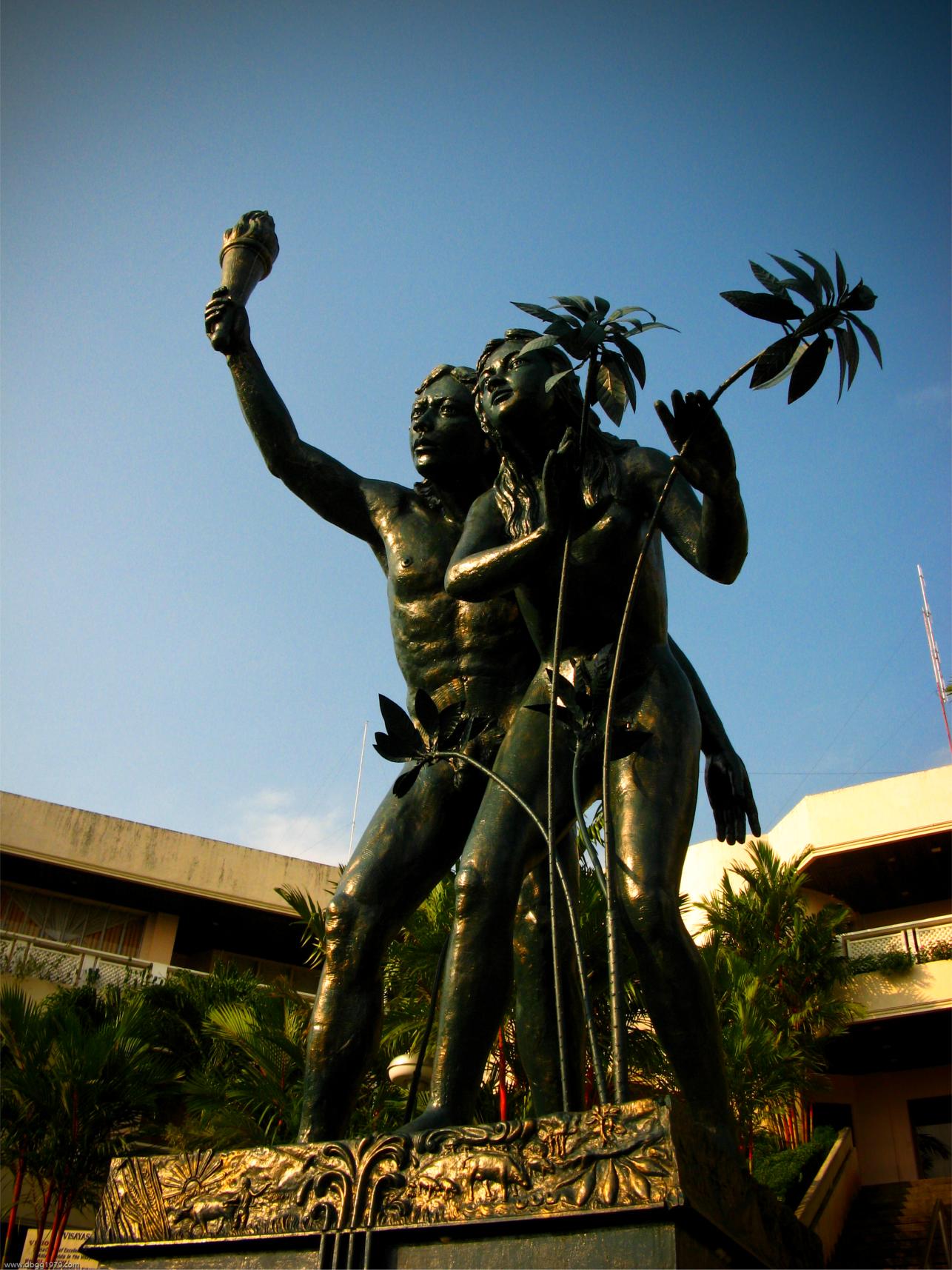Undergraduate
Admission
Undergraduate
Graduate
Location and Facilities
The VSU (main campus) is situated in Barangay Pangasugan, 8 km north of the City of Baybay, Leyte and 34 km south of Ormoc City. It is accessible from both directions because the national road cuts across the University campus. It can also be reached from various points in Leyte either by air through Tacloban City airport (116 km away) or by sea through the ports of Baybay City, Ormoc City, Hilongos (43 km), and Bato (50 km).
Manpower Capabilities
As of January 2002, the VSU main campus had a total of 261 faculty members (95 PhDs, 115 MS, and 51 BS), 175 (67%) of whom had permanent employment status. Some (52) members of the faculty were detailed in research centers and two were on secondment.
There were 296 (1 Ph.D., 15 MS, 126 BS, 44 graduate of certificate courses, 30 college level, 71 high school level, and 9 elementary level) regular administrative staff.
Physical Features
The VSU-Main Campus has a total land area of 1,099.4 hectares that extends from the shore of Camotes Sea to the top of Mt. Pangasugan. It comprises the following:
- Campus Grounds - 61.6 ha.
- Research/Experiments - 94.0 ha.
- Instruction - 3.0 ha.
- Production Area - 104.3 ha.
- Pasture Area - 114.0 ha.
- Forest Reservation - 574.2 ha.
- Coconut - 62.3 ha.
- Abaca - 25.0 ha.
- Rice - 7.0 ha.
- Orchard - 5.0 ha.
- Corn - 3.0 ha.
- Coffee - 2.0
- Roads, Creeks/Marshy Areas - 44.0 ha.
Buildings
The University main campus has 188 buildings: 21 student dormitories, 75 staff houses, 17 academic buildings, 2 Administration buildings, and 63 others which include the Main Library, Student Union, Convention Center, Center for Continuing Education, Infirmary, Guesthouse, Hostel, Pavilion, Cebu and Manila offices, market, cafeteria, high school, elementary, workshop, DA auxiliary, gymnatorium, marine laboratory, fuel depot, powerhouse, motor pool, garage, nurseries, barns, and 9 research/training centers as follows:
- Philippine Root Crop Research and Training Center (PRCRTC)
- National Abaca Research Center (NARC)
- National Coconut Research Center (NCRC) - Visayas
- Farm and Resource Management Institute (FARMI)
- Institute for Strategic Research and Development Studies (ISRDS)
- Philippine Carabao Center (PCC) - Leyte
- Agricultural Training Institute-National Training Center (ATI-NTC) - Visayas
- Multi-Media Development Center (MMDC)
- Institute of Tropical Ecology and Environmental Management (ITEEM)
Enrollment, Transfer, Leave of Absence (College)
Registration periods for the semester and summer terms are reflected in the academic calendar for each school year.
Each student is assigned an academic adviser who shall assist the student in programming his study load and monitor his academic performance every semester.
Every prospective student must enroll during the prescribed registration period. Detailed instructions on enrollment procedures are posted at enrollment time. No enrollment is possible without the necessary credentials. Enrollment by proxy is not allowed.
Bonafide Students. Considered a bonafide student of the University is one who is duly enrolled; that is, who has submitted his valid credentials, has attended classes, and has paid his fees or made arrangements for payment with the University.
Changing of Subjects. During the enrollment period a student may, with the approval of the academic adviser and the department head, change subjects by accomplishing an application for changing of subjects. Changes are not permitted after the close of the official enrollment period.
Dropping of Subjects. With the knowledge of the instructor in the subject and consent of the academic adviser and the department head, a student may drop a subject by accomplishing an application for dropping of subjects provided he has not dropped due to absences. If the dropping takes place after 75 percent of the hours prescribed for the subject has elapsed, the instructor concerned shall be requested to state on the form whether the student shall be dropped without a grade or given grade of "5" on the basis of his class standing for that subject.
The approved forms should be filed with the Registrar's Office for record purposes. Any student who does not follow this procedure shall be given a grade of "5".
Adding of Subjects. A student may add a subject within one week after the opening of classes by accomplishing an application form for adding of subjects and securing the signature of the instructor concerned. Recommendation from the academic adviser and approval of the department head must be secured.
Shifting of Courses. A student may change course or shift from one course to another by accomplishing a prescribed form. No student is allowed to change curriculum without the favorable recommendation of the different signatories in the application form.
Certificate of Transfer Credential (Formerly Honorable Dismissal)
A student who desires to transfer to another school should apply for a certificate of transfer credential. Such certificate will be issued after the applicant has been cleared of all financial and property liabilities to the University.
** However, no certificate of transfer credential shall be issued unless a written request from the student noted by the parent or guardian and approved by the Registrar is presented.
Leave of Absence
A leave of absence not exceeding one academic year may be granted to a student upon presentation of a written petition noted by the parent or guardian to the Registrar stating the reason for the leave.
Withdrawal from the University without a formal leave of absence shall be ground for the curtailment of registration privileges.
Cross Enrollment
(Section 288 - 289, Chapter 42, Visca Code) No Student may enroll simultaneously in two schools without the prior approval of the Registrar. Violation of this rule may cancel the student's right to receive credit for work done in either of the schools.
Permission for cross enrollment is issued by the Registrar upon recommendation of the Dean concerned and only if the applicant is a candidate for graduation during the school year and the course is not offered during the school year in the University or if the subject required for graduation is a conflict with the other subjects.
The maximum number of units for which cross enrollment is ordinarily permitted is six (6) units during the regular term and three (3) units during summer term.
For those coming from other schools, they need to submit a permit to study duly signed by their Registrar.
Summer Study in Another School
A student in the university may enroll in another school during summer session and obtain credit in VSU only upon the prior recommendation of the Dean provided such school is an accredited by AAACUP/PAASCU and other related accrediting agencies.
No permit to study in another school during Summer will be granted for the following:
- Any subject in which the student failed in VSU.
- Any major, specialized or professional subject, in any curricular year.
Visual Identity
The VSU Colors
The VSU colors are green and gold. Green represents nature and the freshness of approach in any academic venture including production or collaboration; gold for the resources and achievements because of excellence in all its endeavors.
The VSU Seal

The circular seal of the University bears the university's name, colors, the years 1924 when the institution was established, a flask with a plant in it on the left side symbolizing agriculture and other fields, and industry. The four interlocking columns forming a square at the middle of the seal depict the four major functions of the University which are instruction, research, extension, and production; and the arrows at the core indicate the basic principles essential to VSU's growth, which are creativity, mutual cooperation, dynamism, and systems approach in problem solving.
The VSU Emblem
The VSU emblem bears the VSU colors and seal and heralds the University's chartered existence, dedication, and strong commitment to education.
The Twin Obelisks

The twin white obelisks at the Main Campus entrance are among VSU's important landmarks that symbolize the academic programs and rural development mandate of the University.
Both structures depict VSU's acknowledgement of providential intervention in pursuit of its programs. The obelisk at the south bears an image of the "god of the sun" and represents the field of agriculture and allied fields. The other obelisk with the "god of lightning and thunder" represents the technology and innovation in all its endeavors.
The Search for Truth
 The Search for Truth Statue in front of the Administration Building consists of two gigantic nude figures of a man and a woman, emphasizing partnership in the quest for truth, knowledge, and the professions. Nakedness symbolizes boldness, impartiality and unemcumbered drive in seeking for truth in its academic pursuits. The statue with inscription at its footstall was conceptualized by Dr. Fernando A. Bernardo, the first President of the Visayas State College of Agriculture.
The Search for Truth Statue in front of the Administration Building consists of two gigantic nude figures of a man and a woman, emphasizing partnership in the quest for truth, knowledge, and the professions. Nakedness symbolizes boldness, impartiality and unemcumbered drive in seeking for truth in its academic pursuits. The statue with inscription at its footstall was conceptualized by Dr. Fernando A. Bernardo, the first President of the Visayas State College of Agriculture.
The inscription reads as follows:
"Let search for truth prevail as a dominant activity of university life. For truth is the guiding light in our paramount mission: the pursuit of excellence.
A teacher must foster intellectual curiosity among students and train them in the art and science of searching for truth to achieve excellence - whether in the classroom, in the laboratory, in nature, or in society."

